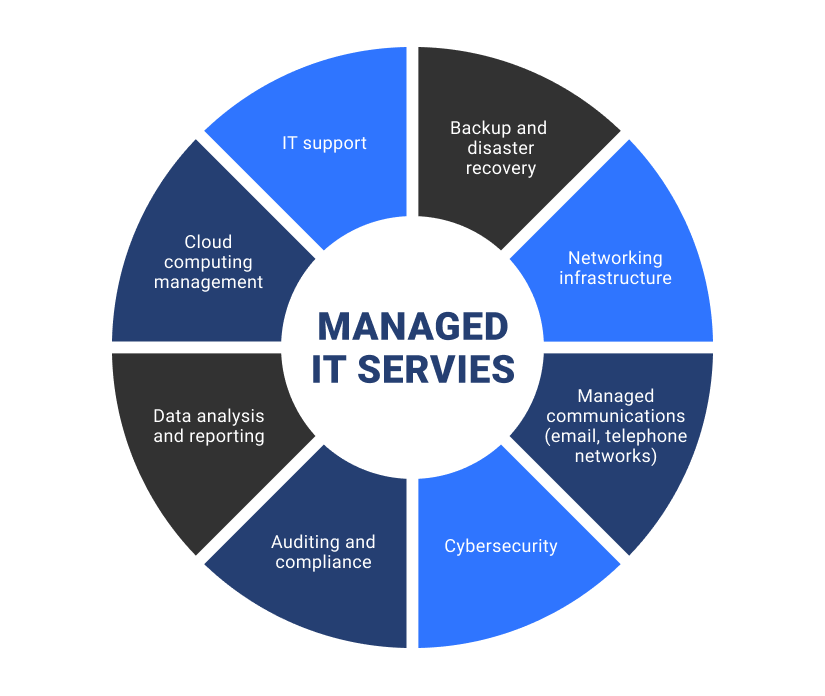As companies increasingly rely on IT to drive innovation and growth, they’re faced with complex challenges: managing infrastructure, protecting against cyber threats, and adapting to ever-changing technologies. For many organizations, the solution is to partner with a Managed Service Provider (MSP).
Table of Contents
What Is Managed Service Provider
But what exactly is an MSP, and how can it help your business thrive?
An MSP is an external company that takes the reins of your IT operations so you can focus on running your business. They offer services that take care of the most critical aspects of your IT environment – infrastructure management, cybersecurity, and data backup – using simplified subscription pricing. Whether you’re a small business trying to stretch your IT budget or a mid-sized company dealing with growing pains, MSPs bring the expertise and scalability you need to stay competitive.
Over 50% of SMBs globally now use MSPs for part of their IT needs, according to recent surveys. Many businesses choose MSPs to simply tackle IT challenges head-on. Others use MSPs to help slash costs and boost efficiency. And still others use MSPs to fill the void by offering access to specialists who know their stuff.
MSPs act as an extension of your team, bringing a wealth of knowledge to the table. They’re not just service providers—they’re strategic partners who help you focus on what matters most: growing your business.
There are countless MSP stories about the increases in productivity, security, and satisfaction MSPs have achieved for their customers, as well as decreases in cost, time to remediation, and successful cyberattacks. These represent what’s possible for your organization with the right MSP in place.
But, before you can choose an MSP, it’s important to understand exactly what roles they take on for your business.
What Services Do MSPs Provide?
MSPs offer a treasure trove of services designed to meet your unique needs. Here are the most common ones:
- Infrastructure Management: Keeping your hardware, software, and networks running like clockwork.
- Remote Monitoring and Management (RMM): Proactively identifying and resolving IT issues before they disrupt your day.
- Managed Backup and Recovery: Provide ongoing management of backups that protect your on-premises and cloud data, as well as cloud application data including Microsoft 365 and Google Workspace to ensure all of your data is safe and accessible.
- Cybersecurity or Security-as-a-Service: Protecting your business with advanced threat detection and response.
- Application Management: Ensuring your business-critical apps stay updated and secure.
- Help Desk Support: Providing fast, friendly assistance via remote connection whenever your team hits a tech snag.
- Cloud Services: Making your transition to and use of the cloud smooth and efficient.
- Auditing and compliance (for instance, HIPAA or ITAR compliance).
A given MSP will have one or more services in addition to the list above, making each MSP unique.

How Are Services Offered?
MSPs keep things simple with subscription-based pricing. You’ll pay a flat monthly fee for a package of services tailored to your needs. For example, a small business might spend $1,500 per month for remote monitoring, managed backup, and cybersecurity. No surprises, no headaches.
Service Level Agreements (SLAs) are another hallmark of MSPs. These agreements outline performance standards and response times, giving you peace of mind that your IT is in good hands. It’s all about reliability, predictability, and trust.
Why Consider Using an MSP?
Still on the fence about hiring an MSP? Consider this: while some businesses can manage with an in-house IT team, many find MSPs to be a game-changer. They’re especially valuable for:
- Limited IT Resources: When you don’t have the staff or expertise to handle IT internally.
- Rapid Growth: If your IT systems can’t keep up with your expanding business.
- Security Concerns: When evolving cyber threats keep you up at night.
- Downtime Issues: If frequent outages are costing you time and money.
MSPs aren’t a one-size-fits-all solution, but for many businesses, they offer the perfect blend of cost-efficiency, expertise, and scalability.
What Are the Benefits of Using an MSP?
Working with an MSP isn’t just about fixing IT issues—it’s about transforming how your business operates. Here’s how:
- Cost Savings: MSPs deliver enterprise-grade IT services at a fraction of the cost of an in-house team.
- Proactive Management: Preventing issues before they disrupt your business.
- Access to Expertise: Giving you a team of IT specialists without the full-time salaries.
- Increased Productivity: Letting your employees focus on their work instead of IT problems.
- Scalability: Adapting to your business’s growth and changing needs.
- Enhanced Security: Using cutting-edge tools to protect against cyber threats.
What Are the Alternatives?
Not every business chooses an MSP, and that’s okay. Some stick with the break-fix model, where you pay for IT support only when something goes wrong. Others build an in-house IT team. But keep in mind:
- Break-Fix Models: These are reactive, not proactive. They solve problems but don’t help you plan for the future or evolve with new technologies.
- In-House IT Teams: Even large teams can struggle with specialized areas like cybersecurity or digital transformation, leaving gaps in your IT strategy.
MSPs, on the other hand, partner with you to ensure your IT evolves alongside your business. They’re in it for the long haul, helping you navigate challenges and seize opportunities.
It should be noted that MSPs don’t all go by the same name. You might hear them referred to themselves as “IT consultants,” “managed IT partners,” or simply “technology service providers.” Regardless of the way they refer to themselves, as long as their mission is to optimize your IT environment and keep your business running smoothly – and do so using easy monthly pricing, they’re likely an MSP.
So, how do you choose the MSP that’s right for your business?


Choosing an MSP
Finding the right MSP is like finding the right business partner—a decision that requires careful consideration and alignment with your organization’s unique needs. A great MSP won’t just deliver services; they will become an extension of your team, working collaboratively to ensure your IT environment supports your business objectives. They’ll help you stay ahead of technological trends, mitigate risks, and unlock opportunities for growth. Here’s what to look for:
- Service Alignment: Do their offerings meet your needs?
- Technology Stack: Are they using tools you trust and value?
- Expertise: Do they have a proven track record?
- Proven Value: Can they back up their claims with case studies and references?
Starting an MSP Business
If you have IT skills and a professional mindset, launching your own MSP business is easier than you may think. It starts with planning your service offerings, pricing, and software stack. Once you have laid that out, the only remaining barrier to running your own MSP is finding your first MSP clients, which is also a challenge that can be overcome with the right approach.

How MSPs Set Prices
Setting prices for managed services is one of the most challenging, but also most critical, aspects of running an MSP business. There are several pricing models that MSPs adopt, each with their pros and cons. In general, the most common approach to MSP pricing is the model known as “All You Can Eat”, which involves offering a flat monthly fee for managed services, based on the number of users or devices supported. However, depending on the types of clients an MSP works with and the services it offers, other pricing strategies may be a better fit.

Contracts and SLAs
Because MSPs guarantee managed services to clients through contractual agreements, understanding how contracts work is an important part of running an MSP business. So is the concept of Service Level Agreements, or SLAs, which define minimum levels of service (such as computer uptime guarantees, or data recovery timelines) that customers can expect as part of a managed services agreement. Inexperienced MSPs sometimes make the mistake of failing to take contracts and SLAs as seriously as they should. They are legal documents, and lawyers should always review the contracts that govern a managed service before they are used to offer the service to clients. MSPs must also be realistic about the SLAs they set. They need to find the right middle ground between guaranteeing a higher level of service than they can comfortably provide on the one hand, and offering a less complete package than competitors on the other. Another important consideration for MSP contracts is to make sure that they specify when a managed service ends so that both the MSP and the client know what to expect regarding service renewal and termination terms.


The MSP’s Software Stack
MSPs rely on a range of tools to do their work. These tools naturally vary, depending on which managed services an MSP offers, although professional services automation (PSA) and remote management and monitoring (RMM) tools are essential to most MSP businesses. Other common MSP software tools include:
- Data backup and recovery software.
- Antivirus and endpoint protection tools.
- Finance software (for managing the finances of an MSP business).
- Documentation databases, for documenting the processes and tools that an MSP uses.
- Ticketing portals, for identifying and tracking the progress of IT issues.
- Monitoring software for keeping track of the status of systems managed by MSPs and generating alerts when something goes wrong.
In most cases, MSPs don’t write their own software tools from scratch. Instead, they build their toolsets from existing software. They tend to turn especially to software that supports the process known as white-labeling, which allows MSPs to take third-party tools and brand them as their own when they interface with customers. In this way, MSPs can build a unified business brand and image, while also providing consistency for customers.
Further reading MSP Software and Hardware Tools
- Essential steps of establishing business
- Building the software stack
- Сreating an onboarding structure, and more
Conclusion
Managed Service Providers are more than just IT vendors—they’re strategic partners that help your business thrive. Whether you’re looking to cut costs, improve security, or scale your operations, an MSP can provide the expertise and support you need. Use this guide to determine if an MSP is right for you and find the perfect fit for your business.





